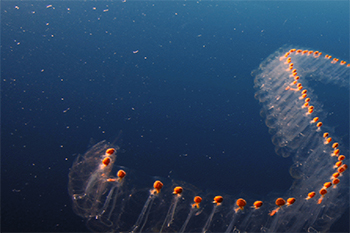Salp
thaliacea

This pelagic creature can be found floating along as a single organism or in chain colonies that can reach several meters in length! The Salp is barrel-shaped with an incurrent on one end and an out current on the opposite end, this design also provide for locomotion in a thrusting jet-like motion. The picture above represents the common physical appearance of Salps with their gelatinous and transparent bodies. Salp are filter-feeders of bacteria and phytoplankton, this helps in the cycling of organic matter therefore playing an important roll in the ecosystem.
During the night, Salps will swim up to feed on the abundant amounts of food near the surface. When the sun begins to rise they descend back down to avoid predators. The Salp never tires or is ever hungry since it is continuously collecting food for energy. Once the Salp reaches a certain size it may begin to reproduce. They can make hundreds of babies at once as a string of cells that divide into tiny animals, all clones and connected together. This reproduction happens until thousands of tiny clones have been released.
Salps come in many different shapes and sizes, some in long snakes, chandeliers or little tubes but all live by the same means. Salps are actually one of the most common occurring animal on Earth even though not many people have ever heard of these alien-like creatures. Little is known about these squishy creatures but with the abundant amount of Salps available , experiments and studies are continuously being conducted in the name of furthering our knowledge of the world we live on.
Research was conducted to predict the prime conditions of temperature and salinity for Salps in the East China Sea. More information about their results can be found in the following link.
Please note that the following references may have either been removed or relocated by the webpage owners since the time this student report was created.
http://www.stmopen.net/statistical-analysis-to-ecological-group-of-thaliacea-in-the-east-china-sea/
Brusca, R. C. and G.J. Brusca. 2003. Invertebrates, 2nd edition. Sinauer, Sunderland, Massachusetts.
Cathy H. Lucas, Kylie A. Pitt, Jennifer E. Purcell, Mario Lebrato, and Robert H. Condon. 2011. What's in a jellyfish? Proximate and elemental composition and biometric relationships for use in biogeochemical studies. Ecology 92:1704.
Madin, Larry. "Jellyfish & Other Zooplankton.": Woods Hole Oceanographic Institution. Woods Hole Oceanographic Institution, n.d. Web. 26 May 2013.
"Statistical Analysis to Ecological Group of Thaliacea in the East China Sea." STMOPENnet. STMOPEN.net, 2013. Web. 26 May 2013.
External Links
Please note that the following links may have either been removed or relocated by the webpage owners since the time this student report was created.
http://science.kqed.org/quest/2012/07/03/ocean-overrun-with-gentle-gelatinous-salps/
http://www.youtube.com/watch?v=-Jooz4gz264
http://www.sciencedaily.com/releases/2010/08/100809161226.htm